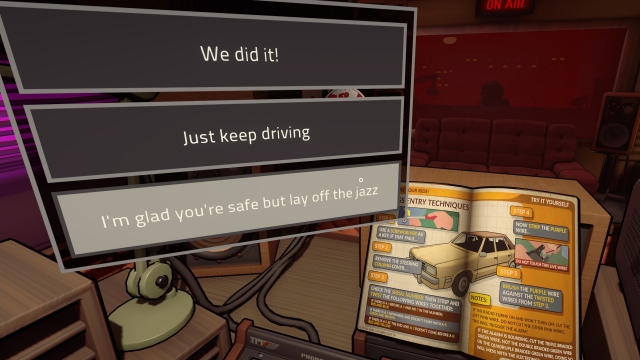
Killer Frequency Preview
It's late night in Gallows Creek, USA, and you — Forrest Nash — are leading the radio show alongside Peggy, your co-host. What should have been a regular work night turns into horror as the first call you receive is from the 911 dispatcher of your small town — she tells you that the sheriff is dead and the deputy is locked up. What do you do?
In Killer Frequency, you take control of the previously-famous radio show host, Forrest Nash, and have to survive the night as the killer-turned-legend, The Whistling Man, wreaks havoc throughout the small town. With the 911 dispatcher out on a four-hour ride to get back up, you'll need to take the 911 calls of Gallows Creek and do your best to keep them alive... or don't.
The narrative unfolds via choices you can make. With each call, you'll need to visualise the scenario and save the caller as best you can by completing puzzles and choosing the suitable options — choose wrong, and The Whistling Man will kill them. Although there is a sense of urgency in the game, the lack of timers and timed events (aside from a few timed dialogue options you have to react quickly to) make this less stressful than it could be — both in a good and bad way, depending on whether you like added pressure in games.

The first two hours of the game feature three cases and various calls from others, as you'll need to add music to fill the silence, respond to callers, and save the ones who meant to call 911. From becoming a pseudo car mechanic to mapping out an area and carefully helping the caller survive in a tight space, you need to make decisions to ensure the safety of the characters from The Whistling Man. Considering we're early on in the experience, the puzzles were straightforward.
The horror-comedy mixture means that you'll get both the thrill and looming stress of the killer roaming Gallows Creek and funny lines from both the callers and the radio hosts. The dialogue managed to get a chuckle out of me several times, though it can be a bit dissonant when the victim is making jokes in the line while actively getting hunted by their killer. Despite how strange these two genres might sound together, the result was definitely enjoyable. The dialogue between characters is closely reminiscent of Firewatch, though with far fewer forest fires and beautiful hikes and instead an office space and the sound of screaming and whistling filling the radio waves. It's pretty much the same, right?
The gameplay boils down to listening to music, doing your best as a radio show host all the while trying to save lives, and finding clues on how to properly ensure your caller survives their next encounter by exploring the office. With items to examine and pick up, you'll head out to the eerie environment and feel the inevitable breathing of The Whistling Man down your neck, despite knowing you're (presumably) safe from him.

The preview ends just as Forrest and Peggy hear the buzzer of the downstairs floor (the entrance) and receive a tape that says "Play On Air". What will it contain?
I cannot wait to experience more of Killer Frequency — I'm already sold on it. We'll find out more when the game releases on the 1st of June!









COMMENTS